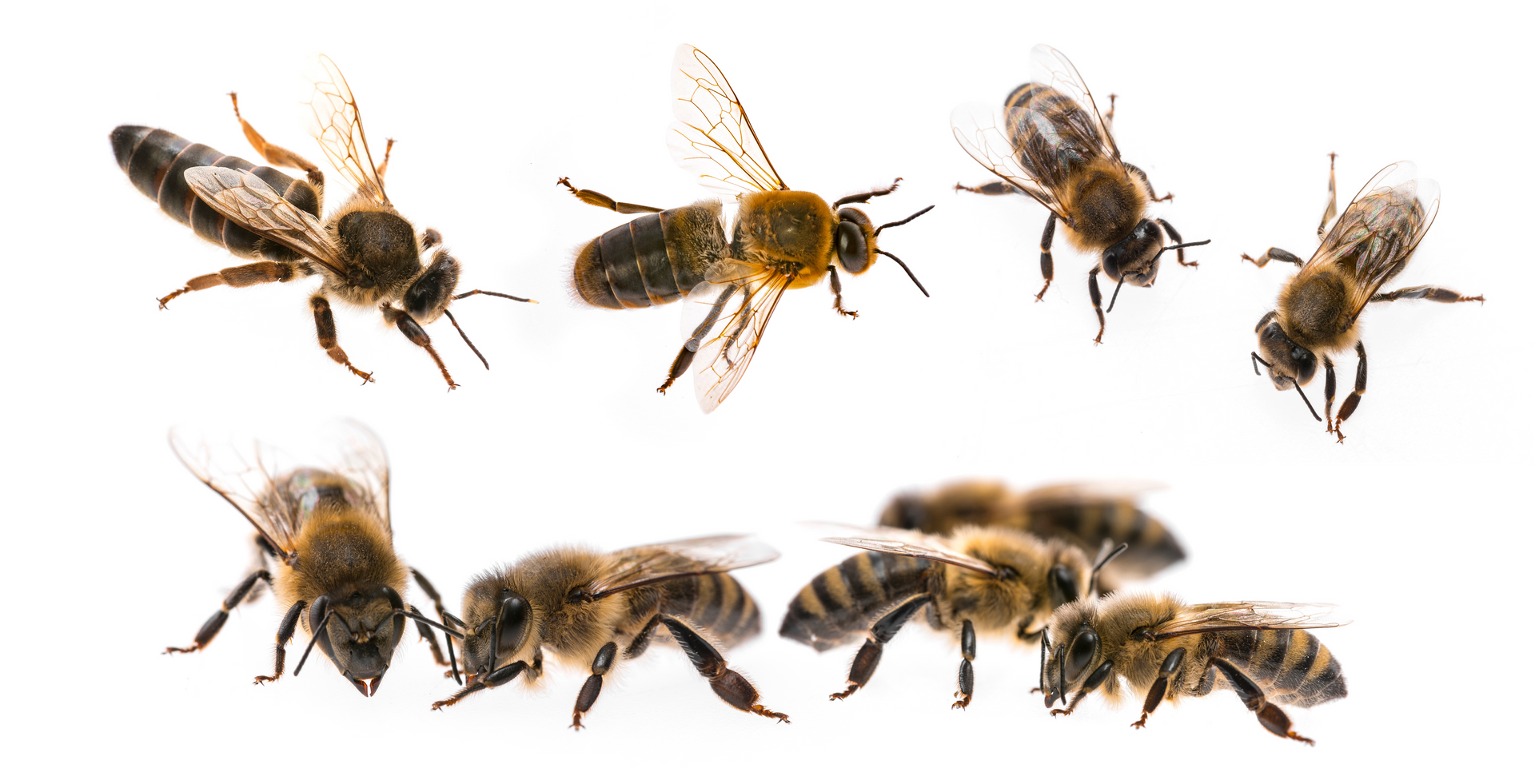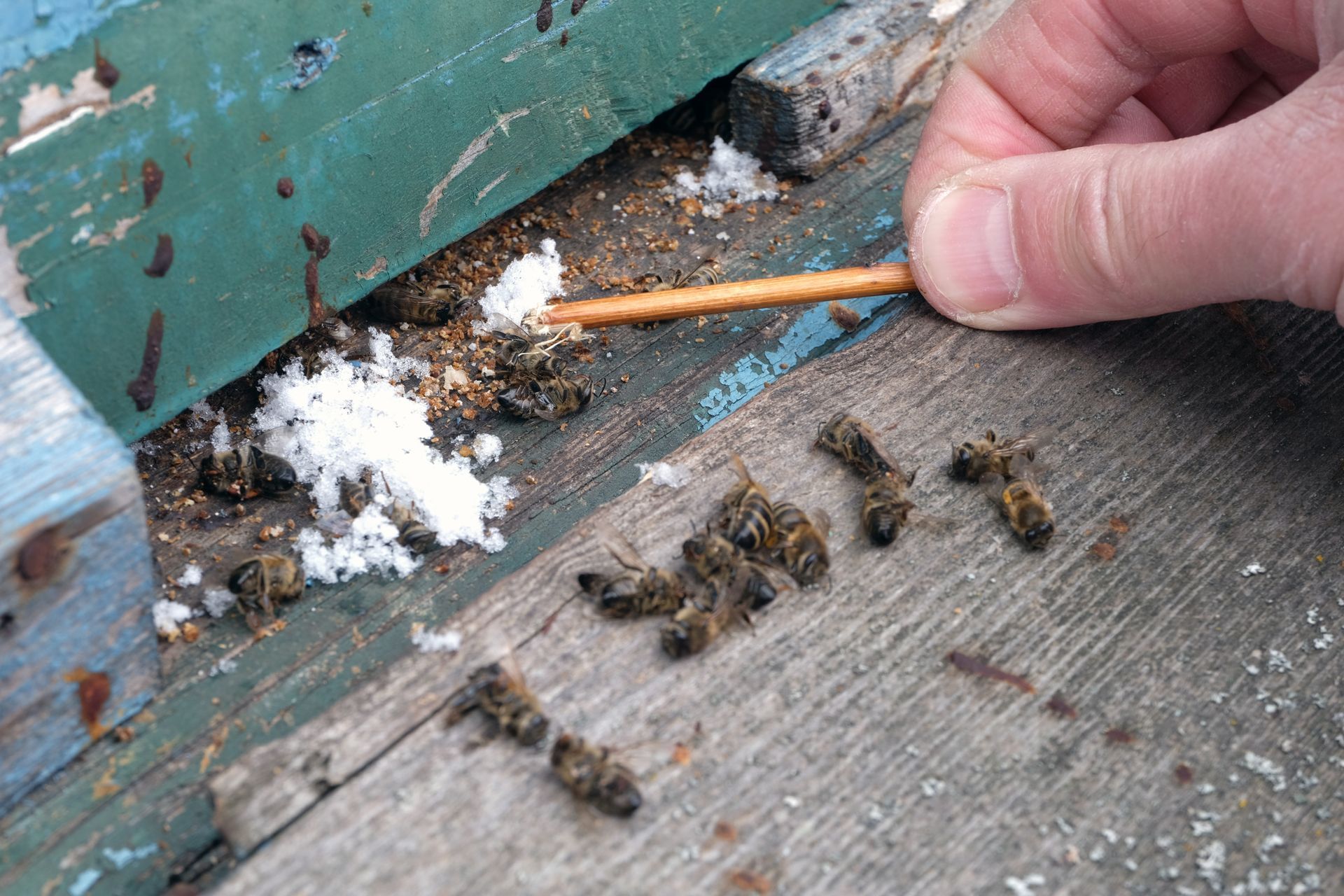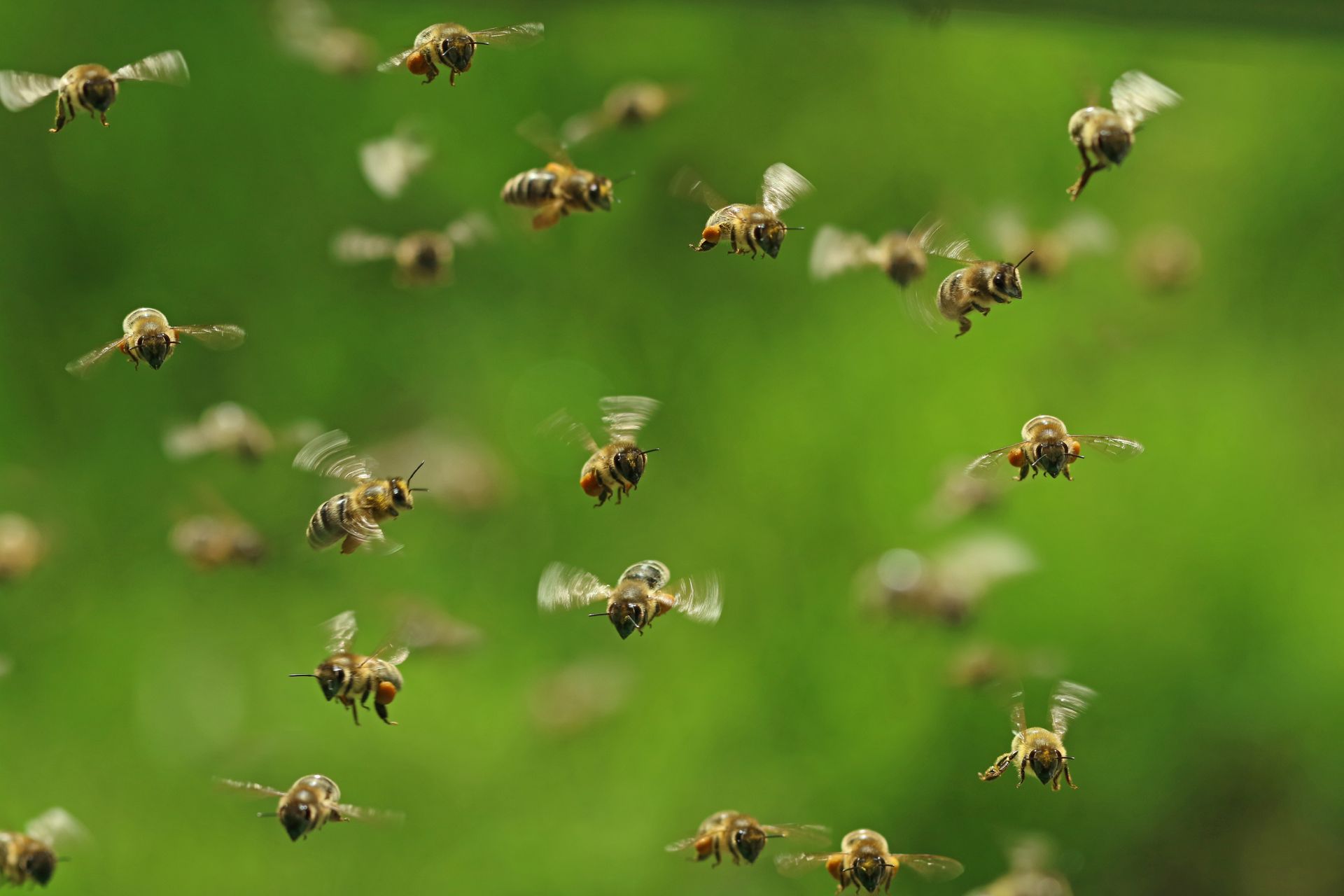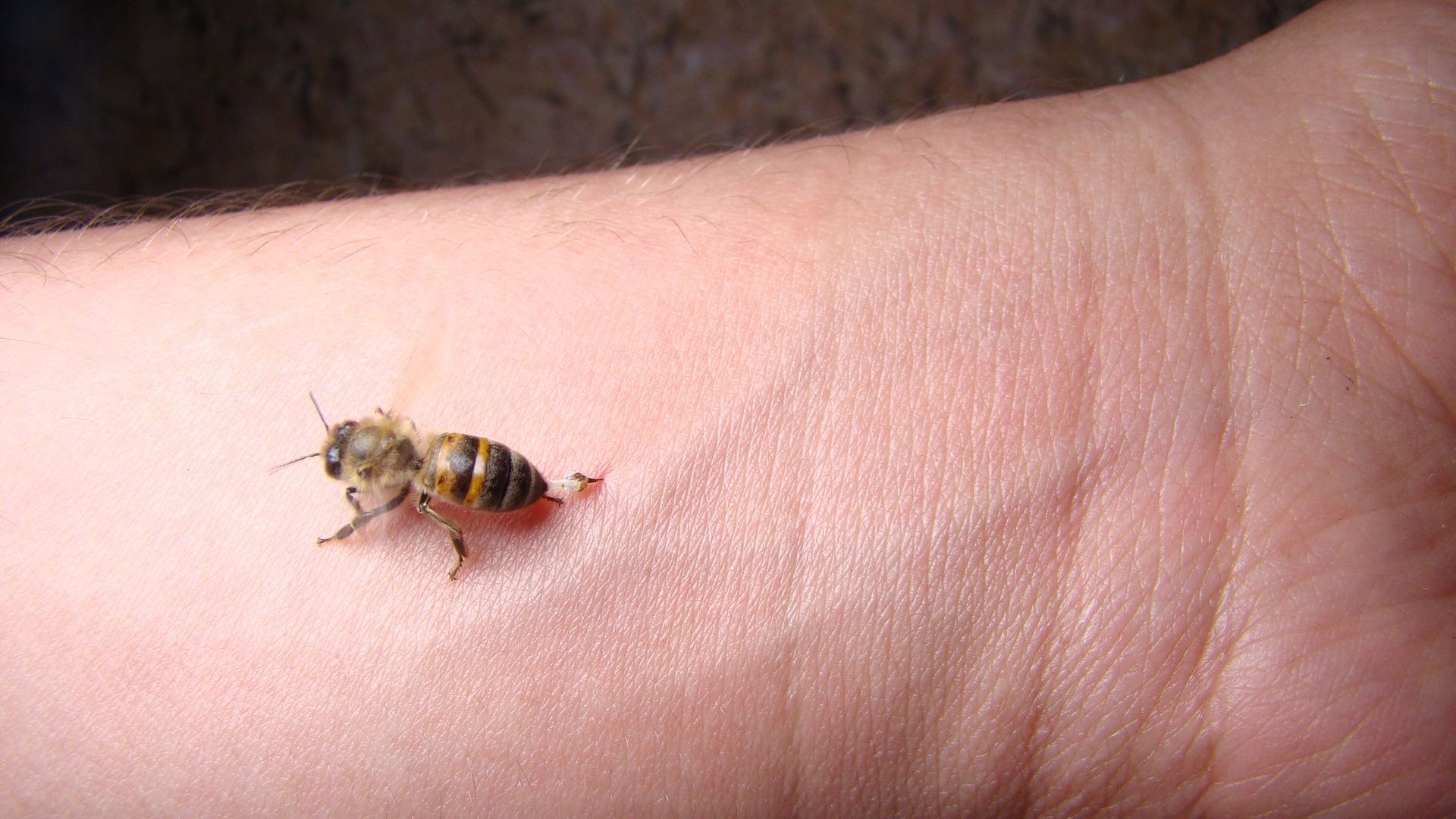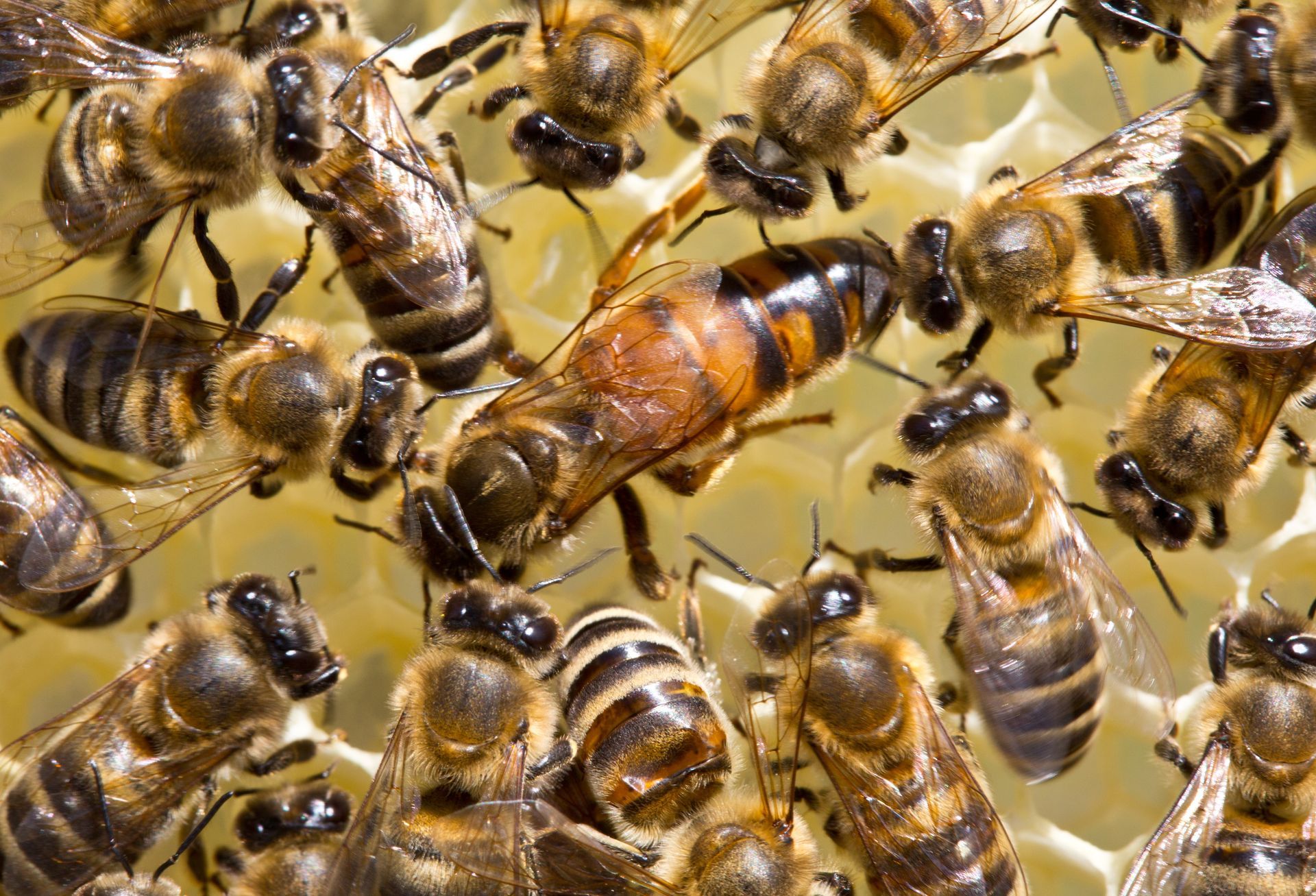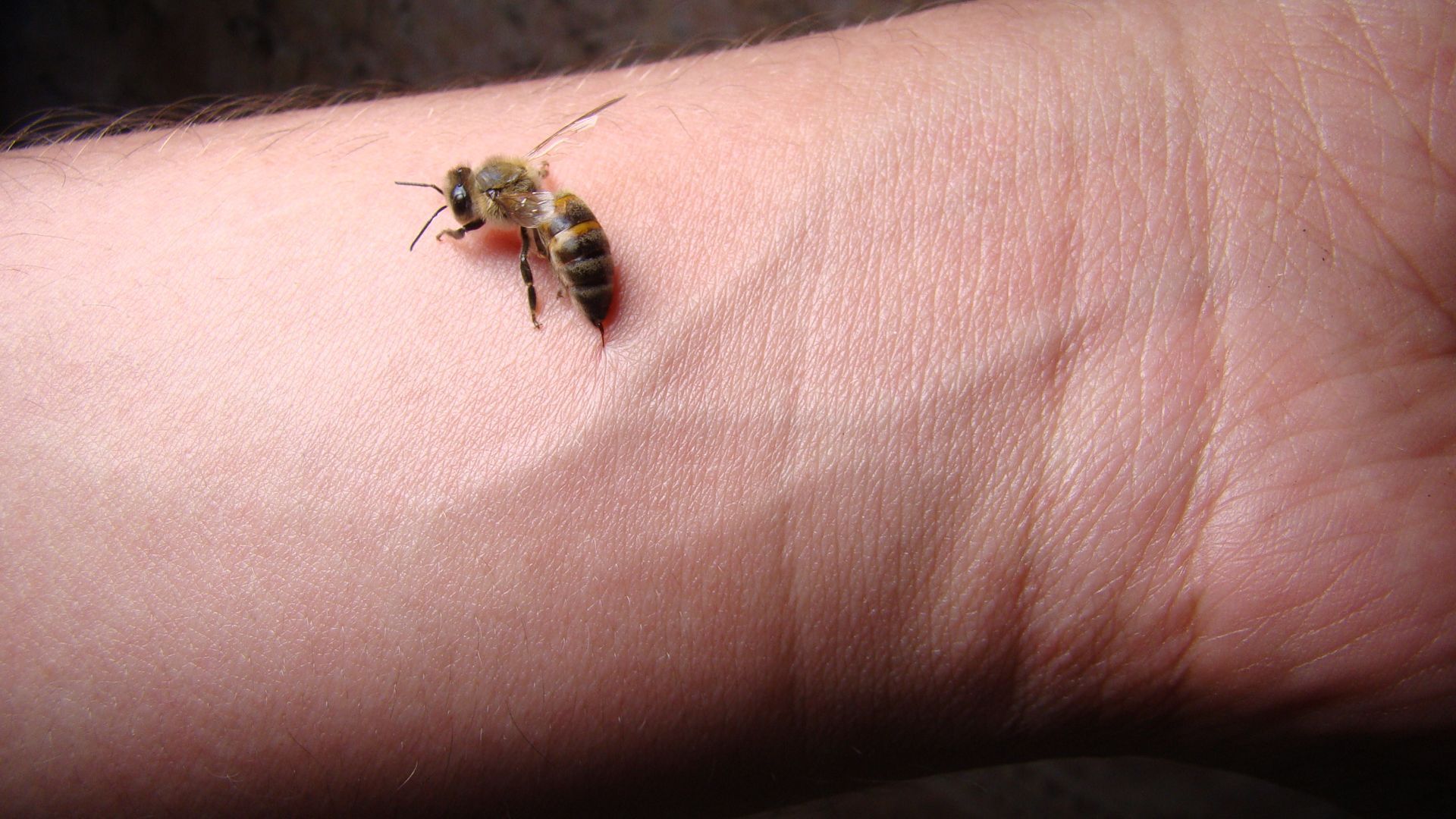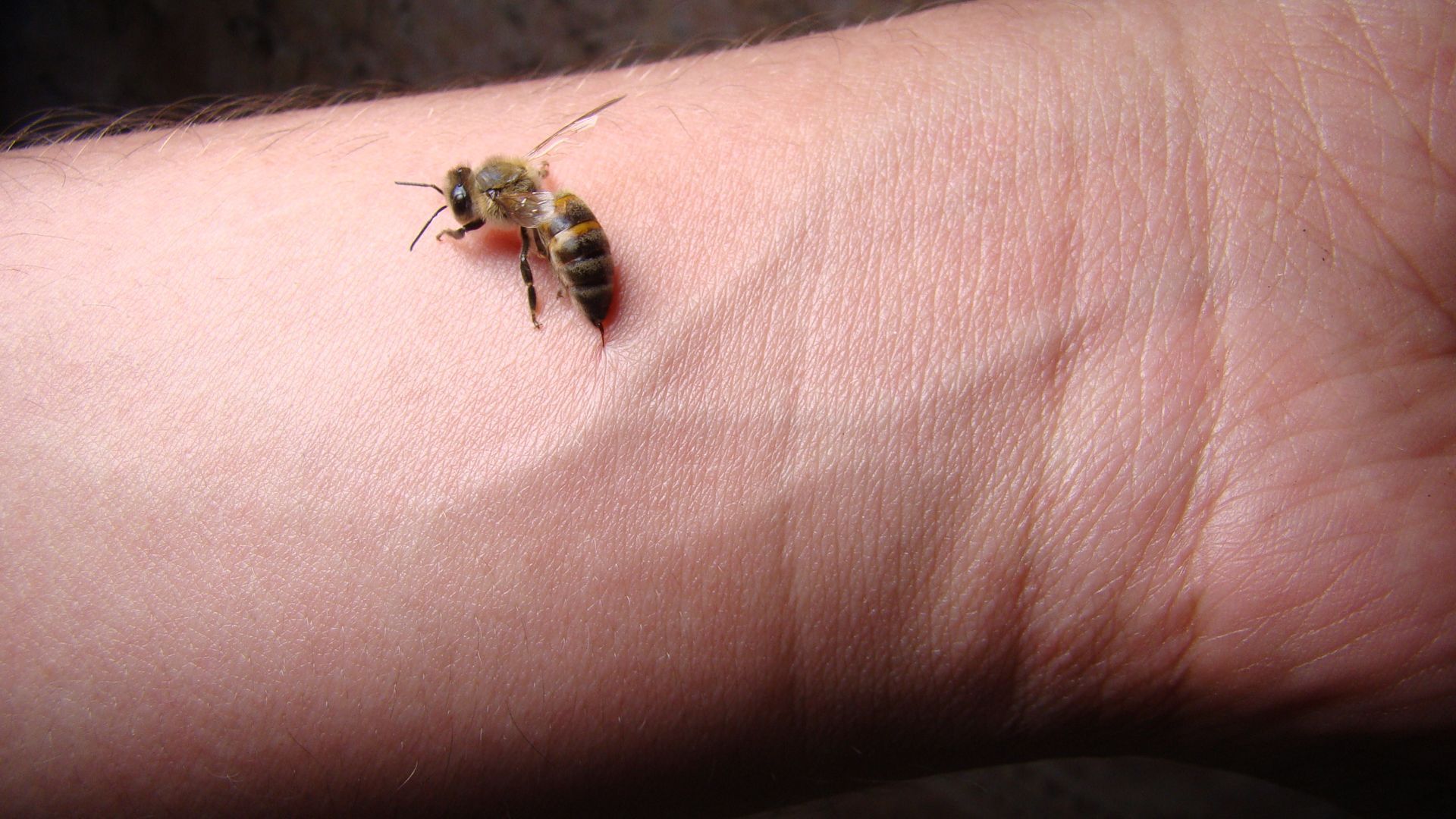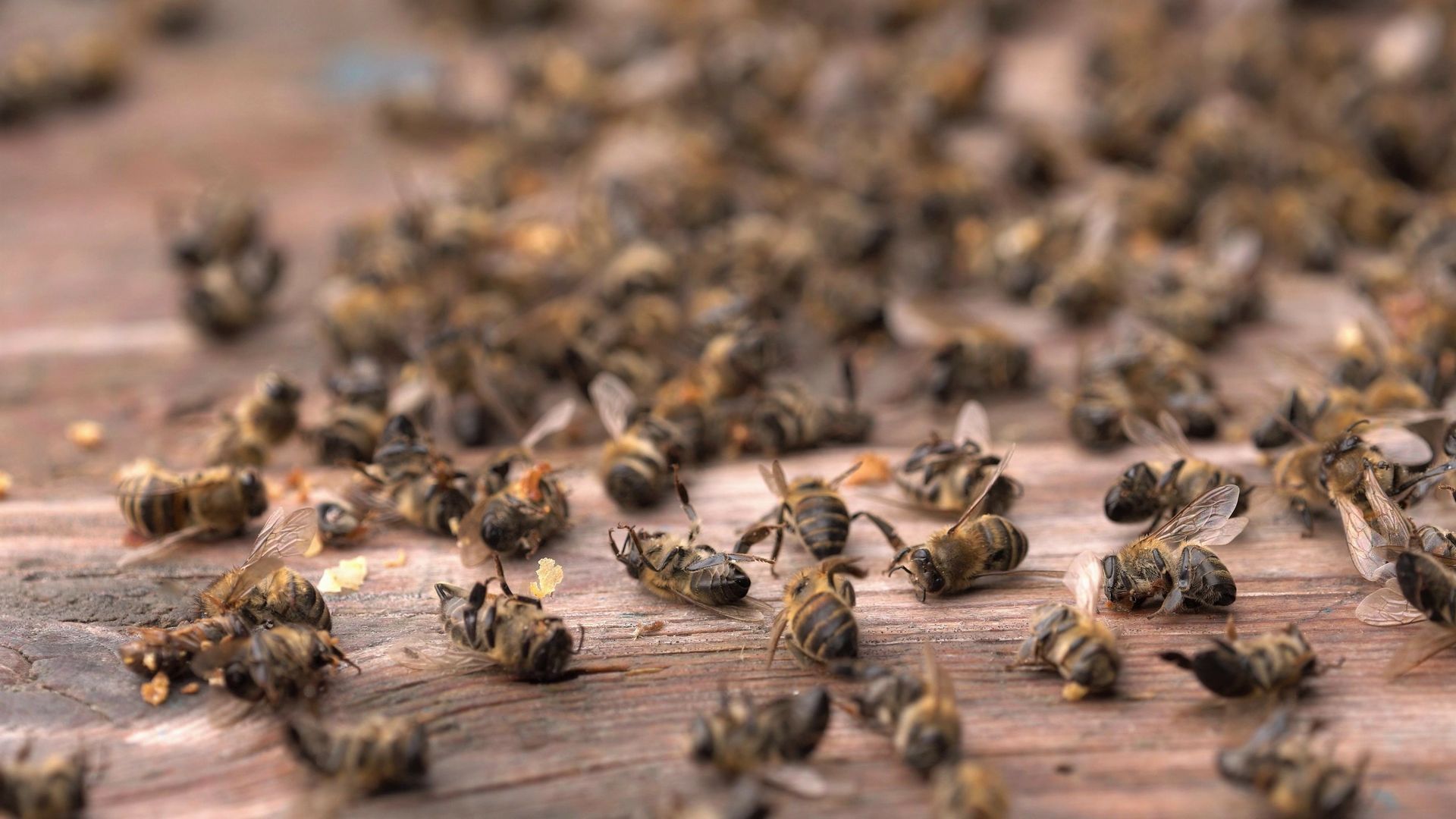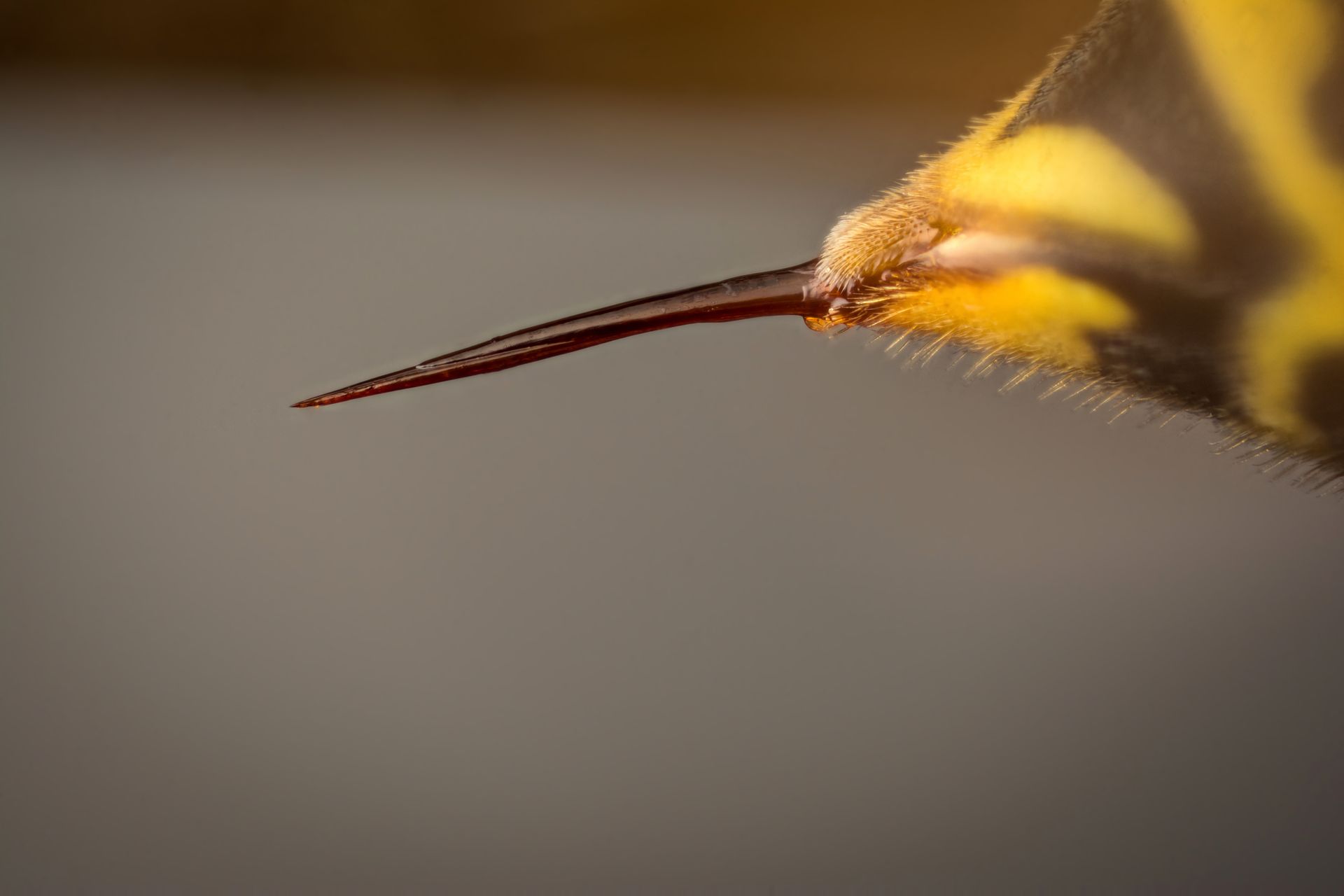Professional Bee Removal Services
When bees establish colonies in or around your home or business, professional intervention becomes crucial for both your safety and the preservation of these important pollinators. Whether you're dealing with honeybees in your walls, carpenter bees damaging your structure, or aggressive colonies near high traffic areas, EcoGuard Pest Management provides expert bee removal solutions that prioritize both human safety and bee conservation when possible.
Call today for a free estimate. 866-326-2847
Pest FREE Guarantee
All Natural Services
Licensed & Insured
Competitive Pricing
Professional Bee Control Experts
Successful bee removal requires specialized knowledge of different bee species, their behaviors, and proper handling techniques. Our certified technicians undergo extensive training in bee biology, hive assessment, and safe removal methods. This expertise allows us to accurately identify bee species, evaluate colony size and accessibility, and determine the most appropriate removal method while considering both safety requirements and conservation priorities.
Why Bees Are a Serious Problem
While bees play a vital role in our ecosystem, colonies in residential and commercial structures create significant risks that require professional attention:
- Severe Health Risks: Bee stings can trigger life threatening allergic reactions in sensitive individuals, with reactions ranging from localized swelling to anaphylactic shock requiring immediate medical intervention. Multiple stings, even to non-allergic individuals, can cause serious medical emergencies.
- Structural Damage: Honeybee colonies inside walls can contain up to 100 pounds of honey and wax, leading to severe structural damage, attracting other pests, and causing costly repairs. Carpenter bees bore into wood, compromising structural integrity over time.
- Defensive Behavior: Established colonies aggressively defend their territory, posing serious risks to people and pets within their flight path. This behavior intensifies during late seasons when food is scarce or when colonies feel threatened.
- Colony Growth: Untreated bee colonies expand rapidly, with honeybee hives potentially growing to 60,000 bees. As colonies grow, they can split and establish new hives nearby, compounding the problem.
Bee Treatment Options
EcoGuard Pest Management is a leader in bee control methodology & service.
Our comprehensive approach to bee control combines multiple strategies based on species, location, and circumstances:
- Species Identification: Professional assessment of bee species and colony type to determine the appropriate removal method and safety precautions needed.
- Hive Removal: Safe extraction of honeybee colonies, including removal of honeycomb and hive materials to prevent reinfestation and secondary pest problems.
- Bee Exclusion: Sealing entry points and potential nesting sites using appropriate materials that prevent future bee colonies from establishing.
- Structure Repair: Professional repair of affected areas after hive removal, including cleaning and sanitizing spaces where colonies were established.
- Prevention Methods: Implementation of deterrent strategies to make your property less attractive to future bee colonies.
- Treatment Options: When relocation isn't possible due to accessibility or safety concerns, we provide targeted treatment solutions that minimize environmental impact.
What Attracts Bees?
Understanding what draws bees to your property helps prevent future colonies from establishing:
- Structure Access: Gaps in siding, weep holes, utility penetrations, and uncapped chimneys provide perfect entry points for colonies seeking protected nesting sites.
- Attractive Plants: Flowering trees, gardens, and certain landscaping choices can initially attract bees, leading them to discover potential nesting sites in your structure.
- Previous Colony Sites: Residual honeycomb scent and wax from previous infestations strongly attract new swarms looking to establish colonies.
- Protected Spaces: Undisturbed areas like wall voids, attic spaces, and hollow trees offer the shelter and stability bees seek for establishing hives.
Signs of a Bee Infestation
Watch for these distinctive indicators of bee activity:
- Large numbers of bees consistently flying in and out of a specific location in your structure
- Visible entrance holes with dark staining around them from bee traffic
- Buzzing sounds within walls, particularly on warm days when colonies are most active
- Brown or yellow staining on exterior walls from honeycomb seepage
- Carpenter bee holes are nearly perfect 1/2 inch circular openings in wood surfaces
- Visible swarms temporarily gathering on structures or trees during spring and early summer
DIY vs Professional Bee Treatment
Attempting DIY bee removal creates serious risks to both personal safety and property. Over the counter sprays and removal attempts often agitate colonies, leading to aggressive defensive behavior while failing to address the underlying problem. Amateur removal efforts frequently result in:
- Increased risk of multiple stings and allergic reactions
- Incomplete removal leaving honeycomb to attract new colonies and create structural damage
- Colony relocation to other parts of the structure
- Property damage from improper extraction methods
- Leftover honeycombs that can attract other pests
Professional bee removal provides crucial advantages through proper equipment, expertise, and methods that ensure complete colony removal while maximizing safety. Technicians assess each situation's unique challenges to determine the most appropriate removal strategy and ensure thorough removal of all hive materials to prevent future problems.
Commercial Bee Control Services
Bee colonies in commercial settings create unique liability concerns and operational challenges. EcoGuard Pest Management provides specialized bee removal programs for businesses that minimize disruption while ensuring customer and employee safety. Our commercial services address the specific challenges bees present across different business environments through customized removal protocols.
We provide expert bee removal solutions for:
- Shopping Centers and Retail Complexes
- Healthcare Facilities
- Schools and Universities
- Hotels and Resorts
- Office Buildings
- Restaurants and Food Service
- Manufacturing Facilities
- Warehouses
- Multi-Unit Housing
- Agricultural Properties
For immediate service for all of your bee control concerns please call 866-326-2847 or complete this form.
Types of Bees
List of Services
-
Western HoneybeesList Item 1
These are the bees that we are most familiar with in southern California. They are pollinators who are in search of food and will not act aggressively unless the hive is threatened.
-
Africanized “Killer” BeesList Item 2
In many ways these bees are like their western cousins. However, this invasive species is one of the most aggressive bee species and will attack in greater numbers when their territory is threatened. The sheer number of stings an individual will receive while being attacked is enough to overwhelm the body.
-
Carpenter BeesList Item 3
These bees are solid black in color and will nest within wooden structures and trees. They will chew through untreated or unpainted wood like termites to create their bee nest. While they are generally not aggressive, these bees can sting multiple times.
-
Bumble BeesList Item 4
These bees are larger than their western cousins but are just as gentle while out searching for food. They are hairier which allows them to survive colder temperatures and higher altitudes, but they generally nest in the ground.
EcoGuard Guarantee
We understand the concerns property owners face with bee problems and back our services with a comprehensive guarantee. If bees return to previously treated areas during your service period, our technicians will return promptly to address the issue at no additional cost. Our commitment includes thorough inspection of previous removal sites, assessment of exclusion repairs, evaluation of preventive measures, swift response to new bee activity, and detailed documentation of all services performed. This guarantee ensures your property remains protected against future bee colonies while maintaining the effectiveness of our initial removal and exclusion work.
Bee Pest Control Process
Initial Inspection: Our certified technicians begin with a comprehensive property inspection to identify bee species, assess colony size, and locate all entry points being used by the bees.
Professional Removal: Our team carefully removes the entire colony including all honeycomb and hive materials to prevent attracting new swarms. The removal process follows strict safety protocols to ensure both property protection and safe handling of these important pollinators.
Exclusion Methods: We seal all entry points using durable materials that prevent future bee infestations while maintaining your structure's integrity. Our exclusion process includes thorough cleaning of affected areas to remove pheromone trails that could attract new colonies.
Ongoing Monitoring: We continue to monitor your property after the initial service, checking exclusion repairs and assessing for any signs of new bee activity. Regular inspections allow us to identify and address potential new entry points before they become problems.
Seasonal Plan for Bee Control
Spring - This season marks the beginning of intense bee activity as overwintered colonies become active and new swarms seek nesting sites. We focus on early intervention during this critical period, inspecting properties for signs of swarming activity and addressing potential entry points.
Summer - Peak bee season requires vigilant monitoring as established colonies reach maximum size and activity levels. We concentrate on managing colonies near high traffic areas while implementing preventive measures around structures.
Fall - As temperatures begin to drop, honeybee colonies prepare for winter by sealing their hives and storing resources. Our focus shifts to removing colonies before they overwinter in structures, which could lead to significant damage from honey seepage and comb expansion.
Winter - Though bee activity decreases, this season provides crucial opportunities for prevention. We concentrate on thorough structural inspections, identifying and sealing potential entry points before spring swarm season begins.
Bee Control FAQs
What's the difference between a honeybee and wasp?
Honeybees are robust, hairy pollinators that build intricate wax combs and can only sting once. Wasps are sleeker, more aggressive insects that build paper nests, can sting multiple times, and don't produce honey or wax structures.
Why should bees be relocated rather than exterminated?
Honeybees are essential pollinators experiencing worldwide population decline, making their preservation crucial for agricultural sustainability and ecosystem health. When possible, professional relocation allows these beneficial insects to continue their vital role while still resolving the property owner's immediate safety concerns.
How do I know if I have honeybees or carpenter bees?
Honeybees are social insects that live in large colonies, with workers constantly entering and exiting a single hive entrance. Carpenter bees are solitary insects that create perfectly round holes in wood surfaces, with individual bees rather than colonies, and males often hovering near these holes to defend territory.
What health risks do bee colonies pose to families?
Bee stings can trigger severe allergic reactions ranging from localized swelling to life threatening anaphylaxis, with multiple stings dangerous even to non-allergic individuals. Indoor colonies also create risks through honey seepage and mold growth, while carpenter bees cause structural damage that can compromise building integrity.
How long does professional bee removal typically take?
A typical live bee removal service takes 2-4 hours, depending on colony size, location, and accessibility. More complex situations, such as colonies inside walls requiring structural modification, may take several days to complete proper removal and repairs.
What happens to the honeycomb during bee removal?
All honeycomb must be completely removed to prevent structural damage and discourage future colonization, as remaining honeycomb can attract new honeybee swarms and cause damage through honey seepage. Professional removal includes extraction of all comb material, followed by thorough cleaning and sanitization of the affected area.
Are relocated bee colonies likely to return?
Properly relocated colonies typically don't return to their original location if all honeycomb and hive materials are removed, and entry points are sealed. However, a new swarm of bees may attempt to colonize the same area if attractive conditions persist, making proper exclusion work essential.
What makes professional bee removal safer than DIY attempts?
Professional bee removal technicians use specialized protective equipment, tools, and techniques developed specifically for safe colony extraction and hive removal. Their expertise allows them to properly assess colony size and behavior, determine the safest removal method, and execute the removal without risking injury or incomplete extraction.
How do bees choose locations for their hives?
Bees seek protected spaces that offer stable temperatures, shelter from elements, and easy access to the outside world. They're particularly attracted to dark cavities like wall voids, chimneys, and attic spaces that resemble their natural nesting sites.
What's included in a professional bee removal service?
A complete service includes species identification, colony assessment, safe removal of bees and all hive materials, structural repair recommendations, and exclusion work to prevent future infestations. The service also includes cleanup of affected areas and guidance on preventing future bee problems.
How extensive can a honeybee colony become?
A mature honeybee colony can contain up to 60,000 bees and produce over 100 pounds of honey and wax comb. These colonies can expand significantly within walls or other void spaces, leading to extensive structural damage if not addressed promptly.
What seasonal patterns affect bee activity?
Bee activity peaks during spring and summer, with spring bringing swarm season as colonies divide and seek new nesting sites. Fall sees reduced activity as colonies prepare for winter, though indoor colonies remain active year round due to stable structure temperatures.
Why do bees build nests in house walls?
Wall voids provide ideal nesting conditions with stable temperatures, protection from predators, and sufficient space for colony expansion. Existing holes, gaps, or previous colony sites make these areas particularly attractive to house hunting swarms.
What structural damage can bee colonies cause?
Honeybee colonies can cause severe structural damage through honey seepage that leads to wood rot, drywall deterioration, and mold growth. Carpenter bees create extensive tunnel systems in wood structures, compromising structural integrity over time.
How do professionals safely remove bees from difficult locations?
Professional removal from challenging locations involves specialized equipment like fiber optic cameras to locate colonies, custom extraction tools, and methods tailored to each situation. Technicians may need to carefully remove sections of walls or siding to access the colony while minimizing structural damage.
What guarantees come with professional bee removal?
Our bee removal guarantee includes free return visits if bees return to treated areas during the warranty period and verification that all exclusion work remains effective. We document all work performed and provide recommendations for preventing future bee problems.
How do weather conditions affect bee removal services?
Bee removal is most effective during daylight hours and moderate temperatures when most of the colony is active and present in the bee nest. Severe weather can delay removal services, as rain and cold temperatures affect bee behavior and make removal more challenging.
What happens if honeycomb is left in walls after removal?
Remaining honeycomb will attract new swarms, leak honey that causes structural damage, and potentially lead to secondary pest infestations. The honey can also seep through walls and ceilings, causing staining and creating ideal conditions for mold growth.
How do professionals protect the property during bee removal?
Technicians use protective coverings and specialized tools to minimize damage during the removal process. They take care to properly seal and repair any areas that must be opened for colony access, ensuring the structure is restored to its preremoval condition.
What preventive measures help avoid future bee infestations?
Prevention involves thorough inspection and sealing of potential entry points, particularly around utility penetrations, vents, and gaps in siding or eaves. Regular property maintenance and prompt repair of any new gaps or holes helps discourage future bee colonization.
How much should bee removal cost?
Professional bee removal costs vary based on colony location, size, and complexity of the removal process. Typical services vary dramatically, with additional costs possible for extensive repair work or difficult to access colonies.
How do you get rid of bees permanently?
Permanent bee control requires a comprehensive approach including complete colony removal, thorough cleaning of the affected area, and proper exclusion work to seal all potential entry points. This three step process, combined with regular inspection and maintenance, provides long-term protection against future infestations.
What's the most effective method for bee control?
The most effective approach combines careful colony removal with thorough exclusion work and preventive measures to discourage future colonization. Success depends on properly identifying the bee species, removing all hive materials, and implementing appropriate exclusion techniques for your specific situation.
How do I get rid of bees permanently?
Permanent bee control requires professional removal of the entire colony, including all honeycomb and hive materials, followed by thorough sealing of entry points and potential access areas. Long term success depends on proper exclusion work that prevents future colonies from establishing, combined with regular property maintenance to address new gaps or deterioration that could attract bees.
What do bees hate the most?
While various home remedies claim to repel bees, these insects are primarily deterred by proper exclusion methods that prevent them from accessing suitable nesting sites. Rather than focusing on repellents, which are largely ineffective against established colonies, professional removal and exclusion provide the only reliable solution for bee problems.
Does vinegar keep bees away?
Vinegar solutions are not an effective or reliable method for controlling bee problems, as they don't address the underlying attraction of suitable nesting sites. Professional removal and exclusion methods provide the only dependable solution for preventing bee colonies from establishing in your property.
Additional Bee Resources
Additional Pest Commonly Treated
See our Pest Library for a full list of insects we treat for. If you don’t see what you are looking for give us a call. We are always here to help! EcoGuard Pest Management provides eco-friendly services for both residential and commercial properties.
Why Choose EcoGuard?
- A pest free guarantee
- Green & ecofriendly pesticides that are state approved
- Licensed, bonded, and insured services
- Competitive pricing




